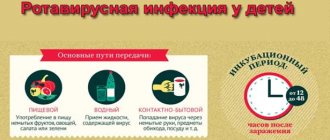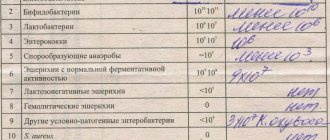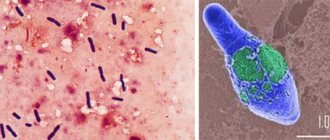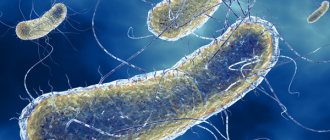2019-03-05
Many parents panic, confusing rotavirus, dysentery and poisoning.
Doctors warn that one of the main differences is the nature of the stool.
- Dysentery is characterized by a discharge mixed with streaks of blood and mucus;
- With rotavirus, the stool is watery.
But in any case, only a doctor can make a correct diagnosis!
It is important to know!
Today, a reliable way to protect against rotavirus infection and dysentery is specific prevention - vaccination!
- "RotaTek" - a vaccine for the prevention of rotavirus infection
- "Shigellvac" - a vaccine for the prevention of dysentery
Diagnosis of the disease is of great importance for successful recovery: to quickly clarify the detailed picture - is it poisoning, dysentery or rotavirus, there is a rapid test for rotavirus.
Rotavirus is an infectious disease that often occurs in preschool children. The causative agent is a specific RNA virus.
The microbe is localized in the cells of the intestinal mucosa and manifests itself with symptoms that are characteristic of many other infectious diseases - salmonellosis, dysentery, cholera, foodborne illnesses, meningitis.
How to recognize rotavirus in a child in a timely manner, what are the distinctive signs of the disease?
Features of the development of rotavirus infection in children and adults
Rotavirus, entering the lumen of the small intestine, leads to the development of rotavirus enteritis. This disease, characterized by a pronounced winter-autumn seasonality, usually occurs in 2 stages: first, symptoms and signs similar to ARVI appear, and then diarrhea joins them. The disease is accompanied by severe vomiting and sometimes an increase in body temperature to +38...+39 ° C, the frequency of diarrhea reaches 4–15 times a day. With massive infection and severe disease, complications may develop, leading to disruption of the water-salt balance and dehydration of the body.
On average, the duration of rotavirus infection is 4–5 days; in rare cases, complete recovery occurs after 10–12 days. In some adults, rotavirus causes unusually severe pain symptoms, due to which patients are admitted to the inpatient department with a general diagnosis of “acute abdominal syndrome.” At the same time, in 30% of cases of infection, intestinal infection can be asymptomatic.
Just like any diarrhea, diarrhea caused by a virus requires specialized treatment, the key element of which is rehydration therapy. Adults and children over 6 years of age can quickly eliminate negative intestinal symptoms using the modern anti-diarrhea drug IMODIUM® Express. This drug, having a selective effect on the receptors of the muscular lining of the intestine, helps to normalize peristaltic contractions, slow down the movement of feces, improve the absorption of fluid and electrolytes, and also increase the tone of the anal sphincter. As a result, due to this, signs of intestinal distress may subside or completely disappear within an hour.
The infection has several other names:
- intestinal flu,
- stomach flu,
- rotavirus enteritis.
The virus that causes this disease is called "rotavirus" due to its appearance (translated from Latin rota means "wheel").
Up to contents
Incubation period
The duration of the incubation period (the time interval from infection to the appearance of the first signs of rotavirus) depends on the state of the immune system and the number of viral particles that have penetrated the intestines. On average it is 3–5 days.
The illness lasts a week, and in some adults, rotavirus symptoms do not stop for 10–12 days. After recovery, the human body develops specific lifelong immunity to the infection, making it almost impossible to become infected again with this type of virus. The exception is people with an initially weakened immune system.
The contagious period begins from the appearance of the first signs of the disease and lasts until recovery. All this time, the sick person continues to release viral particles.
Up to contents
How the virus is transmitted
The main route of transmission of rotavirus infection is fecal-oral. Most often, it enters the body along with contaminated food or raw water. The virus tolerates low temperatures well and can remain viable in the refrigerator for a long period of time.
Infection through airborne droplets is also possible. Like classic, intestinal flu is accompanied by inflammation of the respiratory tract. When you sneeze and cough, viral particles along with tiny droplets of mucus spread through the air and infect those around you who are susceptible to the disease.
Up to contents
What are the differences between the treatment of rotavirus infection and food poisoning?
When food poisoning occurs, it is necessary to remove the food from the body as quickly as possible. This will help avoid complications and alleviate unpleasant symptoms. More often, a person is immediately washed with a stomach, given enterosorbents, plenty of fluids and rehydration solutions to avoid dehydration.
If rotavirus enters the body, gastric lavage will not help. This virus progresses in the blood. Today there is no special treatment; it is carried out mainly symptomatically. The patient, as in case of poisoning, is given rehydration drugs to avoid dehydration.
We recommend: Prevention of sexually transmitted diseases
Both in case of food poisoning and in case of infection with rotavirus, the patient needs a strict diet until his body fully recovers. For rotavirus infection, the recovery period can last up to 3 weeks. In addition, it is necessary to take into account that after the onset of severe symptoms, the patient can be infectious for 1-1.5 weeks.
Where can you get infected with rotavirus?
As a rule, infection occurs in crowded places: in kindergartens, schools, offices, public transport, etc. The disease can manifest itself in isolated cases or epidemic outbreaks, most often occurring in the cold season.
The source of the spread of infection is a patient with a manifest form of intestinal influenza (clinically expressed disease) or a virus carrier. The disease is transmitted only from person to person.
Up to contents
Symptoms
Symptoms of rotavirus infection are nonspecific. Patients develop weakness, headache, nausea, vomiting, and possibly increased body temperature. Respiratory signs of the disease include runny nose, cough, inflammation and redness of the throat. Penetrating the digestive tract, the virus begins to multiply rapidly, affecting mainly the mucous membrane of the small intestine and having a negative effect on digestive function.
By disrupting the physiological processes of food digestion and leading to the development of enteritis (inflammation of the intestinal wall), the intestinal influenza virus causes acute intoxication of the body, causing nausea, vomiting and diarrhea. At the same time, viral particles do not penetrate into the blood.
Up to contents
What makes food poisoning different?
If intoxication of the body occurs after eating spoiled food or improperly processed products, as a result, E. coli or Staphylococcus aureus begins to multiply rapidly. In this case, the incubation period can last from 30 minutes. up to 24 hours.
We recommend: How can you get typhoid fever?
The main symptoms are often nausea, frequent diarrhea and vomiting. The patient may also feel constant weakness and dizziness. Sometimes chills, fever, as well as cramps and heaviness in the stomach, excessive salivation and flatulence occur.
How to distinguish rotavirus from poisoning
Poisoning, unlike rotavirus infection, develops suddenly and very quickly. In this case, similar symptoms usually appear simultaneously in all people who ate the same foods. Rotavirus, which is a seasonal disease, in addition to digestive upset, is accompanied by fever and respiratory symptoms. The characteristic differences of this disease are grayish-yellow feces with a characteristic clayey consistency and very dark urine, sometimes mixed with blood.
Up to contents
General clinical differences of rotavirus
Rotavirus infection rarely occurs in a severe form requiring hospitalization. There are some signs by which one can suspect the disease:
- the most common patients are children from 6 months to 2 years (> 95% of cases);
- the first manifestations occur on the fourth day after infection;
- vomiting once on the first day (there is no constant vomiting);
- There is no blood in the stool.
This infection rarely has an acute onset with severe dehydration.
A correctly collected anamnesis also helps to differentiate the disease and identify rotavirus in a child - data on the onset of the disease, possible route of infection, contact with potential carriers of the virus.
Rotavirus in children
Symptoms in children
In children, immediately after the end of the incubation (latent) period, an acute clinical picture of the disease is observed. From the first day, body temperature rises, nausea, vomiting, and loose stools appear. Diarrhea due to rotavirus has its own specificity: as inflammation develops, the stool acquires a characteristic yellowish-gray color and clay-like consistency. Catarrhal symptoms appear: runny nose, sore throat and sore throat. Possible cough. The child becomes lethargic and capricious and refuses to eat.
Rotavirus infection can cause nausea and vomiting in children not only after eating, but also on an empty stomach. In the first case, undigested pieces of food are found in the vomit, in the second - streaks of mucus. Body temperature, rising to high levels, usually remains at the same level until the end of the disease. If a small child cannot explain what and where it hurts, parents should pay attention to signs such as restlessness, crying, painful bloating, severe rumbling in the stomach, and drowsiness. Possible weight loss.
After the illness ends, children's stool may still have a runny consistency for some time. Due to the fact that the symptoms of rotavirus infection are very similar to food poisoning, as well as manifestations of salmonellosis and cholera, it is almost impossible to determine the cause of the disorder. When the first signs of illness occur, you must call a doctor or ambulance. Before doctors arrive, in order to avoid blurring the clinical picture and making diagnosis difficult, it is not recommended to give antispasmodics and painkillers.
Diet
During the period of this viral infection, a balanced diet and split meals become of particular importance. It is recommended to consult your doctor about its composition in more detail, as there may be individual adjustments. Usually food and drinks are given to the child in small portions, maintaining intervals between meals. Often with this condition, children have no appetite. If, when symptoms of viral diarrhea develop, a child refuses to eat, he should not be forced under any circumstances. However, to replenish the water-salt balance, it is advisable to persuade the baby to drink low-fat chicken broth, weak unsweetened tea, rosehip infusion or jelly.
It is strictly not recommended to give dairy products, which are an excellent breeding ground for the virus, sweets, raw fruits and vegetables, canned food, fatty soups, concentrated juices, pasta, brown bread and baked goods.
After the child shows interest in food, he must be transferred to a therapeutic diet. It usually includes:
- porridge made from semolina or rice flakes, cooked in water or vegetable broth;
- boiled/steamed carrot puree;
- steam omelettes;
- grated fresh cottage cheese;
- baked apples;
- steamed cutlets from lean fish or meat fillets.
The diet for rotavirus in children involves strict limitation of fats, fried foods and carbohydrates.
Up to contents
What we usually call food poisoning, in its essence, most often is not. Poisoning in its pure form is the ingestion of a toxic substance (for example, poisonous mushrooms or berries) into the body. In pediatric practice, we rarely encounter poisonings as such.
Most often we are talking about so-called food poisoning, which from a medical point of view should be divided into food poisoning and intestinal infection.
Food poisoning is a disease in which it is not a microbe that enters the body, but endotoxin (a poison that is contained intracellularly in the microbe). In other words, during heat treatment the microbe was destroyed, but the poisons contained in its cells entered the product. An example of a food poisoning could be poisoning from expired custard cakes, thermally processed dairy products, etc.
Foodborne illness is characterized by a very short incubation period, lasting literally a few hours. Then there is a sharp deterioration in the general condition, vomiting appears, after which it usually becomes easier, for a short period of time the temperature may rise to low-grade levels (more than 37). Unstable stool may occur several times. The next day, a subnormal body temperature appears (below 36.6), severe weakness, then a gradual normalization of the condition. Due to the fact that there is not a microbe in the body, but only a toxin, food poisoning is a disease that occurs very rapidly, begins quickly, but also ends quickly.
The fundamental difference between an acute intestinal infection is that it can only be caused by a microbe that has entered the body. These can be either viral or bacterial intestinal infections. Among viral infections, the most common are rotavirus, enterovirus and noravirus. Among the bacterial ones are salmonellosis, dysentery, etc. The route of transmission of the microbe during intestinal infection is usually fecal-oral, i.e. From the external environment, the microbe first gets onto some product and then into the body.
The incubation period of an intestinal infection can last longer than with a toxic infection, up to several days. The main symptoms of intestinal infection are general malaise, fever, vomiting, and diarrhea.
How to avoid food poisoning?
Under no circumstances should you use low-quality food products. As for food poisoning, it is still more typical for the warm season. And most often it is associated with cakes that contain custard, butter, protein, curd creams, as well as with glazed cheeses and dairy products. They are especially dangerous when sold from open street trays, where they are stored without the correct temperature conditions.
In the case of intestinal infections, one of the most important rules is to thoroughly wash your hands before eating. Before eating, it is imperative to wash vegetables and fruits with hot water, even those that we peel. Very often, when buying, for example, bananas or tangerines, we immediately start eating them without washing them, citing the fact that we are peeling them. But the moment we peel the fruit, microbes from the surface of the peel get onto our hands, and then into the oral cavity. You need to be very careful when handling cut watermelons. After all, a watermelon grows and is stored on the ground, and when it is slightly cut at the time of sale, microbes from its surface enter directly into the pulp. And this applies not only to watermelons - you cannot try any cut vegetables and fruits in the markets.
Another important condition is proper storage of products. You should know that washed and unwashed vegetables and fruits cannot be stored in the same container, because otherwise there will be a mechanical transmission of microbes.
It is imperative to observe the shelf life of ready-made thermally processed food. If you are preparing a salad, germs may be introduced into it during preparation. But if this salad is eaten freshly, these microbes will not be able to multiply enough to cause an intestinal infection. First of all, this applies to vegetable salads and salads with sour cream and mayonnaise dressings. By the way, the air temperature in the refrigerator is optimal for the reproduction of many types of microbes.
It is worth paying attention to drinking water. It has long been the norm throughout the world that water is divided into drinking water and water for domestic use. We have not yet developed a culture of drinking exclusively drinking water. And if you use tap water, it must be boiled.
Treatment of food poisoning
Since any intestinal infection is characterized by vomiting, diarrhea and fever, the most important thing in this situation is to provide the child with a sufficient amount of fluid (more than he loses). With vomit and diarrhea, a large amount of fluid and, as a result, salts are lost, resulting in dehydration (dehydration) of the body. What to drink? It is best to use still mineral water and dried fruit compote, which contains potassium. It can also be tea, jelly, or plain water.
If the body temperature has risen above 38.5, then it must be brought down with the help of antipyretics. The temperature drops to 38 only in children who have a history of seizures or traumatic brain injuries.
It should be emphasized that in case of so-called food poisoning, you should definitely consult a doctor. Firstly, no matter how much liquid a child drinks, only a specialist can adequately assess his hydration (water balance). Secondly, the doctor will be able to prescribe the necessary treatment containing biological products to restore the intestinal microflora. Thirdly, it is important to differentiate whether the infection is viral or bacterial, and whether antibacterial drugs are required. Inappropriate use of antibiotics (incorrect dosage and course duration) can lead to a subclinical form of the disease (carriage). That is, there are no external manifestations of the disease, but it is present in the body. This is dangerous because any decrease in immunity can lead to activation of the microbe and recurrent disease. In addition, a person with such a subclinical form of the disease, without knowing it, can infect the people around him.
In what situations is hospitalization required?
If, against the background of vomiting and diarrhea, parents cannot provide the child with the necessary fluid intake. This manifests itself in the fact that he begins to urinate less often. In this situation, it is necessary to urgently take the child to the hospital, because as a result of dehydration, the kidneys will first suffer.
An absolute indication for hospitalization is also the appearance of blood in the stool.
If there are several children in a family, then in order to avoid cross-infection, it is recommended to isolate the sick child. If for some reason complete isolation cannot be ensured, then hospitalization is also recommended.
How to eat if you have food poisoning?
Previously, it was believed that patients with intestinal infection should be kept on a water-tea break, that is, given water, but not food. But this is a forgotten technique. Modern pediatricians adhere to a different point of view: a child with an intestinal infection can be fed if he wants to eat and can digest food. But if the child does not want to, then there is no need to force feed him.
You can give your child any food, provided that it is boiled, stewed or steamed. Fresh vegetables and fruits, juices, carbonated drinks should be completely excluded, and fats should be limited. The ban also applies to whole milk, milk soup and cottage cheese, with the exception of thermally processed products (for example, porridge with milk, cheesecakes).
While on a therapeutic diet, you need to feed your child often and in small portions.
Compliance with the diet is recommended throughout the acute period of the disease, as well as for several days after the condition returns to normal. However, the final decision must be made by the attending physician.
Dechko Alexander Valerievich, doctor of the first category, director of the private unitary enterprise “Dechko and K” (trademark “Good Doctor”).
Interviewed by Anastasia SHUNTO
Rotavirus infection in adults
Due to the fact that the symptoms of rotavirus in adults are less severe than in children, most patients experience the disease on their legs. The absence of nausea, vomiting and catarrhal symptoms leads to the fact that intestinal disorder is attributed to the consumption of stale foods. However, the asymptomatic course of the disease does not negate the fact that people are carriers and spreaders of the virus. Therefore, the presence of a sick person in a family or group often leads to mass infection, from which one can only protect oneself if one has specific lifelong immunity.
Diagnostics
When diagnosing a disease, not only the clinical symptoms of the disease are taken into account, but also epidemic prerequisites (its seasonality and tendency to mass distribution). Informative methods used to confirm the diagnosis include analysis for rotavirus (detection of the pathogen in feces using electron microscopy), latex agglutination reaction and radioimmune tests.
Due to the similarity of the symptoms of rotavirus infection with salmonellosis, dysentery, cholera, escherichiosis and yersiniosis, differential diagnosis is required.
To diagnose the disease at home, there is a special test for rotavirus, which allows you to detect the pathogen in stool in 10 minutes.
A one-step immunochromatic rapid test, presented in the form of a traditional strip, contains specific antibodies that react to the presence of the rotavirus antigen. Before testing, stool is placed in the supplied bottle of solvent. After the sample is completely dissolved, exactly 5 drops of the resulting liquid are applied to the test window. After 10 minutes, the results are recorded. If rotavirus is present in the stool, a pink stripe appears in the test zone. However, it is important to understand that conducting a test does not replace a consultation with a doctor, so to confirm the diagnosis you must contact a specialist.
Up to contents
How to diagnose rotavirus
In order to detect infection, rapid tests are performed more often. The patient must submit stool or vomit to the laboratory, where the pathogen will be isolated in these tests. The most effective is ELISA - enzyme-linked immunosorbent assay. Pharmacies provide test strips. With their help, a person can quickly determine the presence of infection in the body and its type at home.
Treatment
When answering the question of how to treat rotavirus infection, it should be emphasized that currently there are no specific methods for treating intestinal flu. In this situation, symptomatic therapy is usually used, aimed at correcting water and electrolyte disturbances, stopping vomiting and diarrhea, and preventing the development of dehydration. It is recommended to consult a doctor to prescribe treatment.
To avoid dehydration when treating rotavirus in adults and children, taking rehydrants (medicines containing sodium chloride) may be recommended to restore the water-salt balance. In particularly severe cases, intravenous rehydration is performed.
Patients over 6 years of age may be prescribed IMODIUM® Express to normalize intestinal peristalsis and secretory function and eliminate symptoms of diarrhea. Antibiotics are not taken, since this group of drugs is intended to treat diseases of bacterial origin. In addition, uncontrolled use of antimicrobial agents can cause the development of intestinal dysbiosis.
Up to contents
Complications of rotavirus infection
Most often, intestinal flu occurs without complications. However, when treating the disease, it is very important to prevent dehydration of the body, and also to ensure that in young children the body temperature does not rise above +39 ° C - such a condition can lead to damage to the body’s cells.
However, it is worth paying attention: if you do not consult a doctor and do not treat a viral infection with diarrhea, there is a risk of severe dehydration. In this case, drinking plenty of fluids will not help; it is necessary to administer fluid intravenously under the supervision of specialists. Severe dehydration can even be fatal.
Up to contents
What complications can there be with rotavirus?
The most dangerous complication of infection for an adult is dehydration. Large loss of fluid and salts can occur due to frequent loose stools and vomiting. Dehydration is characterized by the following symptoms:
- extreme thirst and dry mouth;
- headache;
- dry mucous membranes and skin;
- reduction in urination, and then its complete absence;
- shortness of breath and tachycardia;
- the appearance of acetone odor from the mouth;
- lethargy, weakness and drowsiness.
In severe cases, the eyes may become sunken. If the patient exhibits any of the above symptoms, he must be taken to a hospital, where rehydration therapy will be carried out by intravenous drip.
Prevention
One of the means of prevention is vaccination. The rotavirus vaccine (specific vaccine) is presented in the form of a colorless liquid for oral use, containing a weakened strain of the intestinal influenza virus. Vaccination helps the body develop resistance to rotavirus infection.
Nonspecific prevention includes strict adherence to the rules of personal hygiene, including frequent hand washing, drinking only boiled clean water, and others. It is also important to have a complete, balanced diet that can provide the body with all the necessary nutrients and biologically active substances that support and strengthen the immune system.
The information in this article is for reference only and does not replace professional advice from a doctor. To make a diagnosis and prescribe treatment, consult a qualified specialist.
"Imodium is contraindicated for use in children under 6 years of age."
Up to contents








